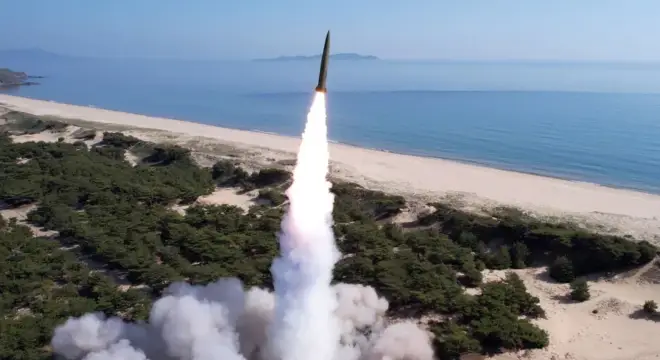As world leaders prepare for the APEC 2025 summit in South Korea, Pyongyang’s latest missile launch signals a calculated blend of provocation and diplomacy.
In a development that stirred worries about regional security, North Korea carried out its first ballistic missile launch in five months on October 22, 2025 — an event now commonly referred to as the North Korea missile test 2025. The missile test occurred only days before the Asia-Pacific Economic Cooperation (APEC 2025 summit) in South Korea, where world leaders would gather to discuss trade, economic cooperation, and stability in the Asia-Pacific region.
According to Seoul’s Joint Chiefs of Staff, multiple short-range ballistic missiles were fired eastward from an area south of Pyongyang. The weapons reportedly traveled around 350 kilometers before landing in waters east of the Korean Peninsula, avoiding Japanese territory. Although there were no injuries or any property damage as a result of the test, its timing is what drew international attention – not for its military significance, but rather for its strategic message.

The Timing: A Message Before the APEC 2025 Summit
This missile launch was not random. It arrived precisely when the international spotlight was shifting to Gyeongju, South Korea, which is hosting the APEC 2025 summit from October 30 to November 1. The gathering, though economic in nature, is symbolically important — bringing together leaders from the United States, China, Japan, and South Korea under one roof.
By conducting the Kim Jong Un missile launch just before the event, Pyongyang ensured it would once again dominate headlines.Analysts and experts assume that the North aimed for two goals with this event: first, to remind the international community that it is a nuclear state; second, to use the test as leverage in future diplomatic negotiations involving sanctions relief.
Analysts also note that such launches have become a familiar playbook for Kim Jong Un. Whenever there is a significant diplomatic or economic event taking place in the region, North Korea involves itself through weapons tests — making itself relevant even if it is not included.
Regional Reactions: Calm, but Observant
After the launch occurred, South Korea’s military announced its own readiness, asserting strong coordination with the United States through their long-standing alliance for defense. Japan’s newly appointed Prime Minister Sanae Takaichi also confirmed that none of the missiles landed within Japanese waters and that there were no reports of damage. Tokyo, however, emphasized close communication with both Washington and Seoul, sharing real-time missile tracking data as part of its response.
Despite these reassurances, regional security observers caution that North Korea’s missile tests — even when short-range — serve as pressure tactics to destabilize diplomacy and test the resolve of U.S. allies in Asia.
Kim Jong Un’s Strategy: Building Leverage Through Firepower
To understand the North Korea missile test 2025, one must look at Kim Jong Un’s evolving nuclear strategy. Since the collapse of his denuclearization talks with former U.S. President Donald Trump in 2019, Kim has steadily accelerated weapons development.
North Korea’s military modernization now includes solid-fuel ballistic missiles, hypersonic glide vehicles, and most recently, the Hwasong-20 intercontinental ballistic missile (ICBM) — showcased at a grand military parade in Pyongyang earlier this month. State media hailed it as the country’s “most powerful nuclear strategic weapon system,” capable of carrying multiple warheads designed to bypass U.S. missile defenses.
This technological leap underscores a core element of North Korea’s nuclear strategy: deterrence through visibility. By openly displaying new missile systems, Pyongyang not only asserts its technological progress but also signals that denuclearization is no longer on the table unless Washington alters its stance on sanctions.
The U.S.–North Korea Relations: Between Nostalgia and New Reality
Interestingly, amid the rising tensions, both Donald Trump and Kim Jong Un have recently struck softer tones. Trump, expected to visit South Korea ahead of APEC for bilateral talks (though not confirmed to attend the main summit), has repeatedly expressed his “good memories” of Kim and hinted at the possibility of renewed dialogue.
For Kim, these nostalgic remarks offer an opportunity to test the waters. After all, U.S.–North Korea relations have long oscillated between hostility and hope. However, analysts suggest that any meaningful engagement will now require Washington to recognize Pyongyang’s de facto nuclear capability — a demand the U.S. has so far resisted.
The North Korean missile test in 2025 thus serves as a reminder and a challenge: a reminder of Pyongyang’s growing weapons capacity and a challenge to Washington’s consistency in foreign diplomacy.

The Wider Geopolitical Context
Apart from the U.S. and South Korea, the launching has also attracted the attention of China and Russia, both significant players in the regional context. Recently, Kim joined Xi Jinping and Vladimir Putin at a military parade in Beijing, confirming his expanding diplomatic and strategic links with both countries.
This trilateral visibility further emphasizes a new reality: North Korea is not isolated as an outcast anymore. Rather, it is choosing to align itself with Beijing and Moscow for tactical reasons to deter Western coercion. So, the missile test being timed with APEC may not be purely about APEC — the rationale could be simply to display that Pyongyang had options outside the U.S.-led order.
Provocation or Diplomacy in Disguise?
Opinions are still divided among observers whether the launch was purely provocation or a deliberate effort to signal its diplomatic intent.
Some analysts suggested that Kim is showing strength to demand recognition as a de facto nuclear state and is presenting the test as a bargaining chip, rather than a hostile act. Others warned that even if these tests are largely symbolic, they pose a greater risk of miscalculation and destabilization through repeated launching.
It is clear, however, that Kim Jong Un, through missile launching, is attempting to conflate provocation and negotiation. We now see missiles serving the dual purposes of domestic legitimacy and to create pretext for international negotiations.
What Lies Ahead
With the APEC 2025 summit around the corner, the timing of this test ensures that North Korea’s nuclear ambitions will hover in the background of every diplomatic conversation. While the summit’s official agenda is trade and economic cooperation, Pyongyang’s missile arsenal will hang over the summit.
Future developments will depend on whether the world’s leaders confront the challenge North Korea poses or ignore that challenge in favor of broader economic discussions. Given Kim’s track record, another demonstration of force — a test of ICBMs is not out of the question — is certainly possible in the months ahead.
Conclusion
The North Korea missile test 2025 constitutes more than simply another place in Pyongyang’s long history of tests and launches; it is a deliberately staged political announcement — one that courses together military strength and diplomatic movement.
As the APEC 2025 summit unfolds in South Korea, the world grapples yet again with the international question of how to balance economic discussions with the persistent events from the Korean Peninsula. It is yet to be determined if this event is a step towards confrontation, or a calculated invitation to negotiate an event.


